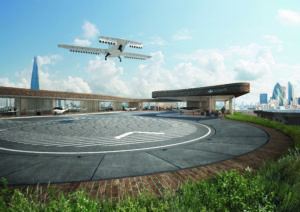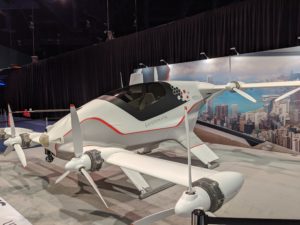eVTOL aircraft that are set to be launched in the next five years could change business aviation forever.
Urban air taxis could be transporting people above our cities within the next five years. At the recent NBAA-BACE event, the association was promoting electric vertical take off and landing aircraft as a major technical trend important for the future of the business aviation sector. Labeled as examples of “urban air mobility” concepts, several futuristic prototypes dominated the exhibition near the keynote presentation area. The futuristic aircraft attracted plenty of attention from curious visitors.
Industry experts speaking at the event in Las Vegas on the topic of UAM (urban air mobility) also seemed impressed. There was consensus at the conference that this new type of aircraft will impact the business aviation sector. Lindsey McFarren, president of McFarren Aviation Consulting, which works with manufacturers and aircraft operators to develop strategy, plan operations, and ensure regulatory compliance said she believes an eVTOL aircraft will be certified by the FAA by 2024. “The technology has improved so rapidly, UAM has moved from a pipe dream to an eventuality quickly. On the regulatory side there is an appetite for it to advance,” she said.

Most experts agree that eVTOLs will be certified and appearing above our cities within the next five years. However, whether the first will appear in the USA, Europe or elsewhere is a matter of debate. Regulation and certification have a massive role to play in eVTOL aircraft’s introduction. The Federal Aviation Administration is taking a case-by-case approach to eVTOL aircraft so far, whereas the European Aviation Safety Administration’s approach is more standardized. Each approach has its own set of drawbacks and advantages.
McFarren says, “We are looking at the UAS [Unmanned Aerial Systems] exemptions that are coming out and considering them precedence, because they are giving us insight into what regulators are thinking. They have to fit into existing framework and make adjustments.

Meanwhile manufacturers and companies, including those from outside of the aviation industry such as Uber (see box: Uber aims to lead the eVTOL charge), are trying to work out how they are going to make money from operating eVTOL aircraft. “It requires a different approach, but it’s a continuum,” says McFarren. “Some of the manufacturers believe that they will operate their own aircraft for reasons of safety. But there will probably be a mix of operators.”
Speed and convenience
Glenn Isbell, vice president of prototyping at Bell, which is developing the Nexus eVTOL, believes the aircraft could affect business aviation operations between cities more than inside them. “Business aviation doesn’t really serve cross-town traffic. But when you get into thin haul, that does impact business aviation. It will be interesting to see what happens between certain city pairs,” he says.
“It will be intriguing to see what happens in the coming years. Business aviation customers are paying for speed and convenience. If you can’t provide that with eVTOLs you won’t have a solution,” he adds.
Kaydon Sanzione is CEO of Jaunt Air Mobility, which is developing the Reduced Rotor Operating Speed Aircraft (Rosa) and is a partner in Uber Elevate. He believes the capability to reduce travel time is what will ultimately convince aviation users to switch to eVTOL aircraft. “For an average journey I have to travel to the airport, go through security and start two and a half hours before boarding time. It’s three and a half hours travel time. When I get to Atlanta, there’s another hour at the airport, he says.
“A seven hour journey is only three and half hours of air travel time. Urban air mobility is about eliminating the three and a half hours around the air travel time.

“Initial eVTOL aircraft aren’t going to be as affordable as the existing general aviation aircraft. The first users will be business and cargo. Transporting executives and staff to meetings, or medical staff and vaccines to remote locations, reducing a trip from hours to a matter of minutes.”
The first eVTOL aircraft pilots will be a mix of traditional rotorcraft and general aviation pilots with new pilots also trained specifically for these aircraft, believes Isbell, and the controls are being designed accordingly. However, he does not see people buying their own flying cars like they own road cars. “The infrastructure can’t support consumers buying their own aircraft,” he says.
“Also, there is a level of complexity that makes integrating the traffic very challenging. Aircraft like Airbus’s Vahana will move at 70-80 knots whereas Nexus will be 130 knots plus – will there be a slow lane and a fast lane? It’s going to be incredibly hard with the mix of different platforms.”
Airspace integration
How to integrate eVTOL aircraft into the current air traffic control system and operate them safely is a question that also bothers Paul McDuffee, business development executive at Boeing Horizon X. The venture and innovation-focused subsidiary of the aircraft manufacturer has invested in companies developing unmanned air traffic management systems and is devising a workable solution. “The $64 million question is how to integrate eVTOLs into an airspace that was never designed to accommodate these things,” says McDuffee.
“They are not really suited to 400ft and below, so we’re looking at above that for these vehicles. NASA are doing a lot of research and testing on how the current aerospace structure can be modified to accommodate these vehicles. Interest has risen to a point where the industry is coming up with solutions.”

McDuffee also believes that defining eVTOLs in terms of “urban” air mobility reduces their potential. “There is more dialogue around the term advanced air mobility,” he says. “They can also operate in remote and rural areas. That makes them useful far beyond just urban areas.”
First applications
Public acceptance of eVTOL aircraft is also a potential barrier to their introduction. It is unknown how the public will react to an increase in air traffic and react to safety and environmental impact issues. These unknown variables play a role in defining that the most likely first commercial applications for eVTOLs will be package and cargo delivery.
The technology and regulation is relatively simpler than for passenger-carrying eVTOLs, especially when considering beyond visual line of sight operations. Development programs for urban delivery drones, backed by companies such as Amazon and UPS are advancing apace. Meanwhile, Boeing and Airbus are both flight testing large cargo-carrying drones for applications such as unloading shipping. The FAA has also amended the Part 135 certification process by granting exemptions to rules that don’t apply to drones, such as the requirement to carry the flight manuals on board.
Despite the challenges, McDuffee insists that eVTOLs are set become a commercial reality. He says, “I’ve been in aviation for 50 years and it’s clear to me that this technology is here to stay. As I wind up my career, I want to make a difference by trying to advance something that I believe will be the future of aviation.
“FAA will do it right and appropriately safe enough in less than five years, but it might not allow access to all levels of airspace all the time.”
Full autonomy

The final part of the picture for urban air mobility is fully autonomous operations. For most companies involved in the nascent sector this is more of an aspiration. Most are focused on putting a piloted eVTOL into the sky first, then developing beyond visual line of sight operations and then full autonomy.
However, McFarren believes that it is not a massive shift to have autonomous aircraft. She says, “The autonomous eVTOL aircraft in development are a continuum of what we have already done. The media makes it sound scary, but in reality, we are already doing some of these things. When we talk to regulators, we are encouraging the mindset that this a continuation of autopilot and enhanced vision systems.”
However McDuffee has a more pragmatic view of autonomous operations. He says, “There is always tremendous concern about autonomy and the debate on different levels of autonomy and how to define those levels will continue.
“There are also issues around the command and control link and how much dedicated spectrum will be allowed on an autonomous vehicle.”
While it may be longer than a decade before the first passengers are transferred by pilotless eVTOL aircraft, it seems inevitable that this new type of aircraft is coming and that it will reshape the aviation sector and society.





